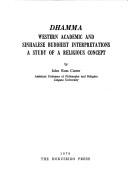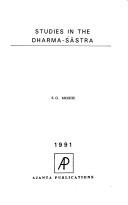| Listing 1 - 10 of 157 | << page >> |
Sort by
|
Book
Year: 1967 Publisher: Amsterdam : Noord-Hollandsche uitgeversmaatschappij,
Abstract | Keywords | Export | Availability | Bookmark
 Loading...
Loading...Choose an application
- Reference Manager
- EndNote
- RefWorks (Direct export to RefWorks)
Book
ISBN: 9782713229978 2713229979 Year: 2023 Publisher: Paris: Éditions de l'École des hautes études en sciences sociales,
Abstract | Keywords | Export | Availability | Bookmark
 Loading...
Loading...Choose an application
- Reference Manager
- EndNote
- RefWorks (Direct export to RefWorks)
Parmi les « but de l'homme » (purusartha) qui orientent la vie humaine dans le monde indien, le dharma occupe une position très élevée, au-dessus de l'« intérêt » (artha) et du « désir » (kama), respectivement la sphère du pouvoir (politique, économique, social) et celle de l'amour (y compris les passions et les plaisirs de la vie). Enfin, le dharma englobe le quatrième et ultime but de l'homme, la « délivrance » (moksa). Le caractère normatif du dharma fixe la place de chacun dans la société, par l'exercice de son devoir spécifique. Mais il ne se décline pas moins selon les dispositions individuelles de chacun, et l'action de l'homme en est la véritable mesure.. Par-delà la littérature du dharma, le volume réunit des enquêtes sur cette notion « en contexte », de la poésie védique à la grammaire, de l'épopée au théâtre, des traditions religieuses et philosophiques - les premières Écoles bouddhiques, la Mimamsa, le tantrisme - à la médecine classique (Ayurveda) et jusqu'à la jurisprudence indienne moderne (du XVIIe au XIXe siècle) avec deux éclairages inédits sur le dharma des femmes.. Une telle approche tend à restituer la complexité de quelques visages du dharma ainsi recomposés, non pas « tel ou tel » aspect mais pour chaque cas le « tout » d'un système à plusieurs facettes, à l'appui d'une histoire singulière dont les auteurs s'attachent à montrer points forts et limites, situations ambiguës, paradoxes et contradictions..
Book
Year: 1956 Publisher: Lucknow : Lucknow University,
Abstract | Keywords | Export | Availability | Bookmark
 Loading...
Loading...Choose an application
- Reference Manager
- EndNote
- RefWorks (Direct export to RefWorks)
Book
ISBN: 9782021050844 202105084X Year: 2011 Publisher: Paris: Seuil,
Abstract | Keywords | Export | Availability | Bookmark
 Loading...
Loading...Choose an application
- Reference Manager
- EndNote
- RefWorks (Direct export to RefWorks)

ISBN: 0893460141 Year: 1978 Publisher: Tokyo Hokuseido
Abstract | Keywords | Export | Availability | Bookmark
 Loading...
Loading...Choose an application
- Reference Manager
- EndNote
- RefWorks (Direct export to RefWorks)
Book
Year: 1967 Publisher: Paris ; La Haye : Mouton,
Abstract | Keywords | Export | Availability | Bookmark
Book
ISBN: 022641857X 9780226418575 Year: 2013 Publisher: Chicago: University of Chicago press,
Abstract | Keywords | Export | Availability | Bookmark
 Loading...
Loading...Choose an application
- Reference Manager
- EndNote
- RefWorks (Direct export to RefWorks)
Insight meditation, which claims to offer practitioners a chance to escape all suffering by perceiving the true nature of reality, is one of the most popular forms of meditation today. The Theravada Buddhist cultures of South and Southeast Asia often see it as the Buddha’s most important gift to humanity. In the first book to examine how this practice came to play such a dominant—and relatively recent—role in Buddhism, Erik Braun takes readers to Burma, revealing that Burmese Buddhists in the colonial period were pioneers in making insight meditation indispensable to modern Buddhism.Braun focuses on the Burmese monk Ledi Sayadaw, a pivotal architect of modern insight meditation, and explores Ledi’s popularization of the study of crucial Buddhist philosophical texts in the early twentieth century. By promoting the study of such abstruse texts, Braun shows, Ledi was able to standardize and simplify meditation methods and make them widely accessible—in part to protect Buddhism in Burma after the British takeover in 1885. Braun also addresses the question of what really constitutes the “modern” in colonial and postcolonial forms of Buddhism, arguing that the emergence of this type of meditation was caused by precolonial factors in Burmese culture as well as the disruptive forces of the colonial era. Offering a readable narrative of the life and legacy of one of modern Buddhism’s most important figures, The Birth of Insight provides an original account of the development of mass meditation.
Book
ISBN: 818315316X 9788183153164 Year: 2018 Publisher: Delhi: New Bharatiya book corporation,
Abstract | Keywords | Export | Availability | Bookmark
 Loading...
Loading...Choose an application
- Reference Manager
- EndNote
- RefWorks (Direct export to RefWorks)
The Veda, as per the commentary of Sayana, is the superhuman means to know the way of attaining the desired result and alleviating the undesired one. The incantations of the Veda are of diverse import. In course of time, the meaning of the Vedic incantations became unintelligible due to various reasons and commentaries were required to explain the meaning. Mimamsa is the sastra developed in India as an aid to understand the meaning of the Veda. It gives various principles in twelve chapters for the interpretation of the Vedic incantations. Its main focus is of course on the performance of the rituals.The principles of interpretations became very important in course of time that the later writers on Dharmasastra and other sastra too resorted to them for drawing conclusion in their sastra. M.M.P.V. Kane gave a description of them in his History of Dharmasastra. Shri Sarkar and other also wrote books on this subject. The present book by Dr. Limaye is a book on the influence of Mimamsa rules of interpretation on popular commentaries of Dharmasastra. It explains how the commentators on Dharmasastra were influenced by the rules of interpretation of Mimansa sastra.

ISBN: 8120203305 Year: 1991 Publisher: Delhi : Ajanta,
Abstract | Keywords | Export | Availability | Bookmark
 Loading...
Loading...Choose an application
- Reference Manager
- EndNote
- RefWorks (Direct export to RefWorks)
Dharma. --- Hindu law.
Book
Year: 2009 Publisher: Boston : Wisdom Publications in association with the Barre Center for Buddhist Studies,
Abstract | Keywords | Export | Availability | Bookmark
 Loading...
Loading...Choose an application
- Reference Manager
- EndNote
- RefWorks (Direct export to RefWorks)
| Listing 1 - 10 of 157 | << page >> |
Sort by
|

 Search
Search Feedback
Feedback About UniCat
About UniCat  Help
Help News
News